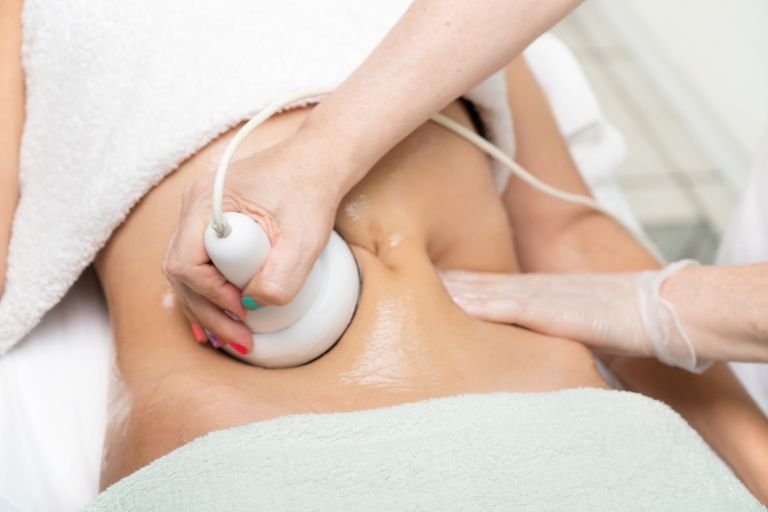- Fitwell Physiotherapy
Transcutaneous Electrical Nerve

Types of TENS
- Conventional TENS: Uses high-frequency (50-100 Hz) and low-intensity currents. It is typically used for acute pain relief.
- Acupuncture-like TENS: Uses low-frequency (1-4 Hz) and high-intensity currents. It mimics the effects of acupuncture and is often used for chronic pain.
- Burst Mode TENS: Combines characteristics of both conventional and acupuncture-like TENS. It delivers bursts of low-frequency pulses, which can be effective for both acute and chronic pain.
- Modulated TENS: Alternates the frequency and intensity to prevent nerve adaptation, maintaining the effectiveness of the treatment over longer periods.
How TENS is Performed
- Preparation: The skin where the electrodes will be placed is cleaned to ensure good contact.
- Electrode Placement: Electrodes are placed on or around the area of pain. The exact placement can vary based on the condition being treated.
- Setting the Device: The TENS unit is turned on, and the settings (frequency, intensity, and duration) are adjusted according to the user’s comfort and the practitioner’s recommendations.
- Treatment Session: Typically lasts between 15 to 60 minutes. The user might feel a tingling or buzzing sensation, but it should not be painful.
- Post-Treatment: Electrodes are removed, and the skin is cleaned again.
Contraindications
TENS is generally safe, but it is not suitable for everyone. Contraindications include:
- Pregnancy: Particularly in the abdominal or pelvic area.
- Pacemakers or other implanted electrical devices: Electrical impulses can interfere with these devices.
- Epilepsy: May increase the risk of seizures.
- Malignancy: Avoid applying TENS over areas with known or suspected malignancy.
- Thrombosis or thrombophlebitis: Risk of dislodging a blood clot.
- Open wounds or skin lesions: Avoid placing electrodes over broken skin.
What to Expect
- Sensation: Users typically feel a mild tingling or buzzing sensation. It should not be painful; if it is, the intensity should be reduced.
- Duration: Sessions usually last 15-60 minutes and can be repeated several times a day if necessary.
- Immediate Relief: Some users may experience immediate pain relief, while for others, it may take a few sessions.
- Adjustment: Settings may need to be adjusted over time to maintain effectiveness and comfort.
Benefits
- Pain Relief: Effective for a variety of conditions including arthritis, back pain, neck pain, tendinitis, and postoperative pain.
- Non-invasive: Provides an alternative to medications and invasive procedures.
- Portable and Convenient: Can be used at home or on the go, providing continuous pain management.
- Muscle Relaxation: Helps to relax muscles and reduce muscle spasms.
- No Known Serious Side Effects: Generally safe when used as directed.
Conclusion
TENS is a versatile and effective method for managing pain without the need for medications or invasive treatments. It is important for users to understand the proper use of the device, adhere to contraindications, and consult healthcare professionals to optimize the benefits while minimizing risks.
Frequently Asked Questions
TENS stands for Transcutaneous Electrical Nerve Stimulation. It is a pain relief method that uses low-voltage electrical currents delivered through electrodes placed on the skin. The electrical impulses can help reduce pain by blocking pain signals to the brain and stimulating the production of endorphins, the body’s natural painkillers.
TENS therapy is commonly used to treat a variety of conditions that cause pain, including chronic back pain, arthritis, postoperative pain, menstrual pain, sports injuries, and neuropathic pain. It is also sometimes used for muscle rehabilitation and to improve circulation in certain conditions.
TENS therapy is generally considered safe for most people when used correctly. Common side effects are usually mild and may include skin irritation or redness at the site of the electrodes. However, TENS should not be used by individuals with pacemakers, defibrillators, or other implanted electrical devices, and it is not recommended for use during pregnancy without medical advice.
A typical TENS therapy session can last between 15 to 60 minutes, depending on the individual’s needs and the advice of a healthcare provider. The frequency of use can vary, but it is often recommended to use TENS therapy several times a day, with at least a few hours between sessions. It’s important to follow the guidance of a healthcare provider to determine the appropriate duration and frequency.
Yes, TENS therapy can be used at home with a portable TENS unit, which is available for purchase over-the-counter or by prescription. To get started, you will need a TENS unit, electrodes, and conducting gel or adhesive pads. It is important to read the instructions carefully and, if possible, receive guidance from a healthcare professional on the proper use and placement of the electrodes to ensure effective and safe treatment.
Related Therapies
How Fitwell Physiotherapy Can Help?
Dr. Richa’s Fitwell physiotherapy has an extensive team of physiotherapists all within their own specialist areas of physiotherapy. Whatever your condition, we guarantee that we will have the best physiotherapist for you. We assess, diagnose, plan, cure and care for you.
Fitwell Physiotherapy Clinic, Pune provides you best physiotherapy treatment in Kharadi, pune. We also serve Chandan Nagar, Vadgaon Sheri, Keshav Nagar, Wagholi & nearby Areas in Pune. We are experts in treating Neck Pain, Hand Pain, Back Pain, Lower Back Pain, Knee Pain, Stiff Neck, Sciatica, Arthritis, Stroke Paralysis & Post Surgical Rehab.
We provide Specialized physiotherapy treatments in Sports Injuries, Pre and post Surgery, Neurologic, Pediatric, Chronic Pain/Fatigue, Rheumatology, Women’s Health, Men’s Health, Ergonomics, Vestibular, Amputees & all sort of Pain treatment and lifestyle conditions.



























